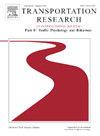Unraveling the complex interplay between curved tunnels and drivers’ physiological responses: An HRV perspective
IF 3.5
2区 工程技术
Q1 PSYCHOLOGY, APPLIED
Transportation Research Part F-Traffic Psychology and Behaviour
Pub Date : 2024-11-23
DOI:10.1016/j.trf.2024.11.020
引用次数: 0
Abstract
This study aims to unravel the complex interplay between curved tunnels and drivers’ physiological responses from an HRV (Heart Rate Variability) perspective. A group of 30 individuals with valid driver’s licenses was selected, and their HRV was monitored while driving through four curved tunnels in Yunnan Province, China. HRV indicators such as RMSSD (Root Mean Square of Successive Differences), SDNN (Standard Deviation of Normal-to-Normal Intervals), LF (Low Frequency), and LF/HF (ratio of Low Frequency to High Frequency) were analyzed. The independent variables included tunnel radius, turn direction, and zone characteristics. The results demonstrated that the radius, turning, and zone of the curved tunnel significantly influenced drivers’ HRV. Specifically, as the tunnel radius decreased, the mean RMSSD and SDNN of drivers decreased, while the mean LF and LF/HF increased. In left turns, drivers had lower RMSSD and SDNN values but higher LF and LF/HF ratios compared to right turns. Additionally, drivers showed the highest mean RMSSD and SDNN in the entrance zone of the tunnel, followed by the middle zone, and the lowest in the exit zone. Conversely, the exit zone had the highest mean LF and LF/HF, followed by the middle zone, and the entrance zone had the lowest. These results indicate that the characteristics of the curved tunnel have a substantial impact on drivers’ physiological responses. A smaller tunnel radius leads to increased stress and cognitive load, as reflected by the decreased HRV metrics and increased sympathetic activity. Turning maneuvers, particularly left turns, result in asymmetry in autonomic responses, with lower RMSSD and SDNN and higher LF and LF/HF during left turns. The variations in HRV across different zones within the tunnel suggest that environmental cues play a role in sympathetic activation, with the exit zone showing the highest sympathetic activity. These findings offer significant insights into the relationship between tunnel conditions and drivers’ physiological responses, emphasizing the importance of considering these factors in road safety and human factors engineering. By comprehending how tunnel characteristics affect drivers’ autonomic nervous system responses, we can formulate strategies to enhance driver well-being and safety.
揭示弯曲隧道与驾驶员生理反应之间复杂的相互作用:心率变异的视角
本研究旨在从心率变异(HRV)的角度揭示弯曲隧道与驾驶者生理反应之间复杂的相互作用。研究选取了 30 名持有有效驾照的驾驶员,对他们在中国云南省驾车通过四条弯道隧道时的心率变异进行了监测。分析的心率变异指标包括RMSSD(连续差值的均方根)、SDNN(正常与正常间期的标准偏差)、LF(低频)和LF/HF(低频与高频之比)。自变量包括隧道半径、转弯方向和区域特征。结果表明,弯道隧道的半径、转弯方向和区域对驾驶员的心率变异有显著影响。具体而言,随着隧道半径的减小,驾驶员的平均 RMSSD 和 SDNN 下降,而平均 LF 和 LF/HF 上升。与右转相比,左转时驾驶员的RMSSD和SDNN值较低,但LF和LF/HF比率较高。此外,驾驶员在隧道入口区的平均 RMSSD 和 SDNN 值最高,其次是中间区,出口区最低。相反,出口区的平均 LF 和 LF/HF 最高,中间区次之,入口区最低。这些结果表明,弯曲隧道的特点对驾驶员的生理反应有很大影响。较小的隧道半径会导致压力和认知负荷的增加,这从心率变异指标的下降和交感神经活动的增加可以反映出来。转弯动作,尤其是左转弯,导致自律神经反应不对称,左转弯时 RMSSD 和 SDNN 较低,LF 和 LF/HF 较高。隧道内不同区域心率变异的变化表明,环境线索在交感神经激活中发挥了作用,出口区域的交感神经活性最高。这些发现为了解隧道条件与驾驶员生理反应之间的关系提供了重要启示,强调了在道路安全和人因工程中考虑这些因素的重要性。通过了解隧道特征如何影响驾驶员的自律神经系统反应,我们可以制定出提高驾驶员健康和安全的策略。
本文章由计算机程序翻译,如有差异,请以英文原文为准。
求助全文
约1分钟内获得全文
求助全文
来源期刊
CiteScore
7.60
自引率
14.60%
发文量
239
审稿时长
71 days
期刊介绍:
Transportation Research Part F: Traffic Psychology and Behaviour focuses on the behavioural and psychological aspects of traffic and transport. The aim of the journal is to enhance theory development, improve the quality of empirical studies and to stimulate the application of research findings in practice. TRF provides a focus and a means of communication for the considerable amount of research activities that are now being carried out in this field. The journal provides a forum for transportation researchers, psychologists, ergonomists, engineers and policy-makers with an interest in traffic and transport psychology.

 求助内容:
求助内容: 应助结果提醒方式:
应助结果提醒方式:


